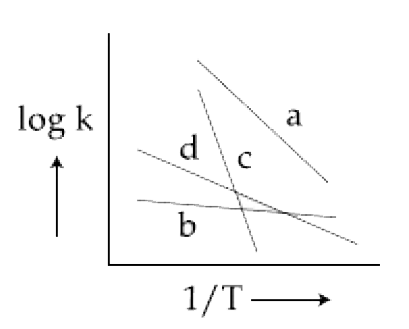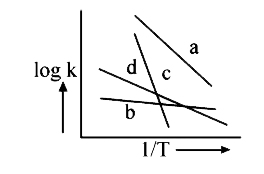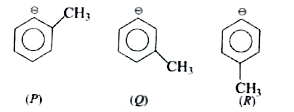Which of the following order is correct?
K+<Ca2+<P3−<S2− Ionic size
Na+aq.>K+aq.>Rb+aq.>Cs+aq.: Electrical conductance
Al3+aq.>Mg2+aq.>Na+aq.: Hydrated size
I−aq.<Br−aq.>Cl−aq.>F−aq.: Ionic mobility
The correct Answer is:C
To determine the correct order among the given options, we will analyze each case step by step.
Step 1: Analyze Ionic Size
We are given the ions S²⁻, P³⁻, Ca²⁺, and K⁺.
- Ionic Size Trend: The size of anions increases with an increase in negative charge, while the size of cations decreases with an increase in positive charge.
- Comparison:
- P³⁻ has the largest size due to the highest negative charge.
- S²⁻ is next, as it has a lower negative charge than P³⁻.
- K⁺ is larger than Ca²⁺ because K⁺ has a +1 charge while Ca²⁺ has a +2 charge.
- Ca²⁺ is the smallest due to its +2 charge.
Order: P³⁻ > S²⁻ > K⁺ > Ca²⁺
Step 2: Analyze Electrical Conductance
We are given the cations Na⁺, K⁺, Rb⁺, and Cs⁺.
- Conductance Trend: Conductance is inversely related to ionic size. Smaller ions have higher conductance due to better mobility.
- Comparison:
- Na⁺ is the smallest and has the highest conductance.
- K⁺ is larger than Na⁺ but smaller than Rb⁺.
- Rb⁺ is larger than K⁺ but smaller than Cs⁺.
- Cs⁺ is the largest and has the lowest conductance.
Order: Cs⁺ > Rb⁺ > K⁺ > Na⁺ (in terms of conductance, this is reversed)
Step 3: Analyze Hydrated Size
We are given Al³⁺, Mg²⁺, and Na⁺.
- Hydrated Size Trend: The hydrated size is influenced by the charge and size of the cation. Higher charged cations have a smaller ionic radius but can have a larger hydrated radius due to stronger hydration.
- Comparison:
- Al³⁺ has the highest charge and will have the largest hydrated radius.
- Mg²⁺ is next, as it has a +2 charge.
- Na⁺ has the lowest charge and thus the smallest hydrated radius.
Order: Al³⁺ > Mg²⁺ > Na⁺
Step 4: Analyze Ionic Mobility
We are given F⁻, Cl⁻, Br⁻, and I⁻.
- Ionic Mobility Trend: Ionic mobility increases with increasing ionic size (for ions with the same charge).
- Comparison:
- I⁻ is the largest and has the highest mobility.
- Br⁻ is next, followed by Cl⁻.
- F⁻ is the smallest and has the lowest mobility.
Order: I⁻ > Br⁻ > Cl⁻ > F⁻
Conclusion
After analyzing all the orders, we find that the only correct order is the hydrated size order: Al³⁺ > Mg²⁺ > Na⁺.
Final Answer
The correct order is: Al³⁺ > Mg²⁺ > Na⁺.
---
We are given the ions S²⁻, P³⁻, Ca²⁺, and K⁺.
- Comparison:
- P³⁻ has the largest size due to the highest negative charge.
- S²⁻ is next, as it has a lower negative charge than P³⁻.
- K⁺ is larger than Ca²⁺ because K⁺ has a +1 charge while Ca²⁺ has a +2 charge.
- Ca²⁺ is the smallest due to its +2 charge.
We are given the cations Na⁺, K⁺, Rb⁺, and Cs⁺.
- Comparison:
- Na⁺ is the smallest and has the highest conductance.
- K⁺ is larger than Na⁺ but smaller than Rb⁺.
- Rb⁺ is larger than K⁺ but smaller than Cs⁺.
- Cs⁺ is the largest and has the lowest conductance.
We are given Al³⁺, Mg²⁺, and Na⁺.
- Comparison:
- Al³⁺ has the highest charge and will have the largest hydrated radius.
- Mg²⁺ is next, as it has a +2 charge.
- Na⁺ has the lowest charge and thus the smallest hydrated radius.
We are given F⁻, Cl⁻, Br⁻, and I⁻.
- Comparison:
- I⁻ is the largest and has the highest mobility.
- Br⁻ is next, followed by Cl⁻.
- F⁻ is the smallest and has the lowest mobility.
After analyzing all the orders, we find that the only correct order is the hydrated size order: Al³⁺ > Mg²⁺ > Na⁺.
The correct order is: Al³⁺ > Mg²⁺ > Na⁺.
Topper's Solved these Questions
- BOOK - VK JAISWAL ENGLISHCHAPTER - s-BLOCK ELEMENTSEXERCISE - Level 349videos
s-BLOCK ELEMENTS
- BOOK - VK JAISWAL ENGLISHCHAPTER - s-BLOCK ELEMENTSEXERCISE - ONE OR MORE ANSWER IS/ARE CORRECT66videos
s-BLOCK ELEMENTS
- BOOK - VK JAISWAL ENGLISHCHAPTER - s-BLOCK ELEMENTSEXERCISE - SUBJECTIVE PROBLEMS2videos
s-BLOCK ELEMENTS
- BOOK - VK JAISWAL ENGLISHCHAPTER - QUALITATIVE INORGANIC ANALYSISEXERCISE - SUBJECTIVE PROBLEMS4videos
QUALITATIVE INORGANIC ANALYSIS
- BOOK - VK JAISWAL ENGLISHCHAPTER - TYPES OF REACTIONSEXERCISE - SUBJECTIVE PROBLEMS42videos
TYPES OF REACTIONS
Similar Questions
Consider the following plots of rate constant versus 1T for four different reactions. Which of the following orders is correct for the activation energies of these reactions ?
 View Solution
View SolutionConsider the following plots of rate constant versus 1T for four different reactions. Which of the following orders is correct for the activation energies of these reactions?
 View Solution
View Solution
Knowledge Check
- Question 1 - Select One
Which of the following orders is correct ordre of these anions?
 AQ>R>PBQ>P>RCR>Q>PDP>Q>R
AQ>R>PBQ>P>RCR>Q>PDP>Q>R - Question 2 - Select One

Which of the following orders is correct for heat of hydrogenation of these compounds ?AI>III>IIBIII>II>ICIII>I>IIDII>I>III - Question 3 - Select One

Which of the following orders is correct for heat of hydrogenation of these compounds ?AI>II>IIIBIII>II>ICII>III>IDIII>I>II
Which of the following orders are correct for property indicated in brackets ? .
View SolutionWhich of the following orders is correct for hyperconjugation of these radicals?
 View Solution
View SolutionWhich of the following orders is correct for heat of hydrogenation of these compounds?
 View Solution
View SolutionWhich of the following orders is correct for the stability of these carbocations?
 View Solution
View SolutionWhich of the following orders is correct for the magnitude of +M power among these compounds?
 View Solution
View Solution

